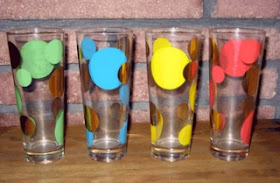According to Ann Kerr in Collector's Encyclopedia of Russel Wright, Wright's relationship with Imperial began in 1941 when they produced the seeded glass Flair. In 1949 the Flame line was added, which was later called Twist. These patterns were said to be produced in seaspray (a pale aqua), hemlock (a deep forest green), ripe olive (a deep brown), verde (a green gold) and crystal. These (first and third pictures below) were shown in an early Imperial ad in Kerr's book, along with the Pinch pattern. Kerr also included photos of a slightly different shape of Flair glassware, like the second photo below, although she didn't include an ad verifying the identification. My knowledge isn't extensive enough to confirm or refute this attribution.
 |
| Flair by Imperial (spelled "Flare" in early ads) worthpoint.com |
 |
| Another Flair shape, according to Ann Kerr modfather.com |
 |
| Twist by Imperial (originally called Flame) modfather.com |
The Pinch line by Imperial was added in 1951 to accompany Iroquois Casual. It was produced in verde, seafoam, smoke, cantaloupe, chartreuse, ruby, pink and crystal.
 |
| Pinch by Imperial modfather.com |
In 1957 Wright was commissioned to decorate the Oklahoma line of Bartlett-Collins in Sapulpa, Oklahoma. The only two designs he allowed his name to be used with in advertising were Eclipse and Asterisk, though other styles were later produced in the tapered Oklahoma shape, as well as in a straight shape. Fellow blogger wedgwoodtulsa has a nice post about Eclipse glassware, as well as the best photos I found of all four colors. In 1958 they were called blue, flamingo, yellow and green, and all had gold moons. In 1960 the color names were changed to blue, tangerine, yellow and green, although flamingo and tangerine were likely the same color.
 |
| Eclipse by Bartlett-Collins, sometimes called Sooner glasses wedgwoodtulsa.blogspot.com |
 |
| Asterisk by Bartlett-Collins modfather.com |
In 1963 Wright contracted with Yamato in Japan to produce the Theme Formal line, which included these opaline white glasses. Advance sales were not successful, and there are indications that only samples were produced.
 |
| Theme Formal by Yamato modfather.com |
I hope this information is beneficial to those of you who are new to Russel Wright glassware and helps you get some great bargains when you're hitting estate sales, thrift stores or eBay.

thanks for this, can't wait to search the next flea market for these gems!
ReplyDelete@Carey: Glad you think it will be helpful! Happy hunting and good luck...:)
ReplyDeleteDana, many thanks for the Russel Wright masterclass. I'm no longer clueless, at least.
ReplyDelete@I dream lo-tech: The least I can do is return the favor. I'm learning so much from you about typewriters!
ReplyDeleteHuh! Who knew...I have a set of three "rocks" Asterisk glasses in blue and gold!
ReplyDelete@Mr.Mod: Cool...the start of another collection?
ReplyDeleteThere was never a Flair line that Wright designed produced by Imperial. This is a long-standing confusion based on an old Imperial ad which says "Flare with Flair." The glass you show second from the top is a line that Russel Wright designed for his American Way program around 1940 and was produced by Imperial in only one run. It never made it to market. The colors were made to match the American Modern Dinnerware line (coral, seafoam, chartreuse, and gray). There is documentation in the Imperial Glass Museum which clarifies all of this. The textured finish on the glassware is Imperial's 'lalique' finish. Interestingly, in one of Kerr's books (3rd edition maybe?) she publishes a document which references this American Way line, the shapes & colors.
ReplyDeleteInteresting...thanks for that information.
DeleteThe top photo you show is indeed "Flare" which is always a blister glass with bubbles. There is no line called "Flair." Also - (I'll need to check my notes) I believe Russel Wright did not design "Twist." He only designed the Flame shape and Imperial added twist later.
ReplyDeleteToday, it is important for you to realize that glassware is not just any accessories that can be purchased based on price. Last few years glassware has emerged as one of the key factors in restaurant business that have gained a considerable importance.
ReplyDeleteI'm late to this party but excited to have confirmation of the Flare pattern in the first picture. I bought 12 (!) of these a few years ago based on a photo in Ann Kerr's book and on Modfather's site. However, when I got a copy of the Keller and Ross book there was no mention of this nor on any other online site I visited until today. Thanks
ReplyDeleteWelcome, Margaret. I'm glad you found this post helpful. I hope you'll stop by the blog often.
DeleteHow much are the small Flare juice glasses worth?
ReplyDeleteProbably the best place to find out what they're selling for now is Replacements, Ltd.
DeleteThanks ALL for the information ... the comments are equally as useful as the post. Good discussion. I see a lot of references on the web to Morgantown glass as well, what's the connection to Russel Wright and this manufacturer?
ReplyDeleteMorgantown manufactured Wright's American Modern glassware, which he designed to go with his Steubenville American Modern tableware.
DeleteI would appreciate some expertise MCM glass help. I grew use using Russell Wright Highlight dinnerware that my parents bought around 1953. We had matching glassware that looked similar to the Flare picture above, but it was much more angular at the flare point. I suspect it was made by Morgantown or Paden City Glass. It’s currently in storage so I don’t have a picture. Is anyone familiar with this glassware?
ReplyDelete